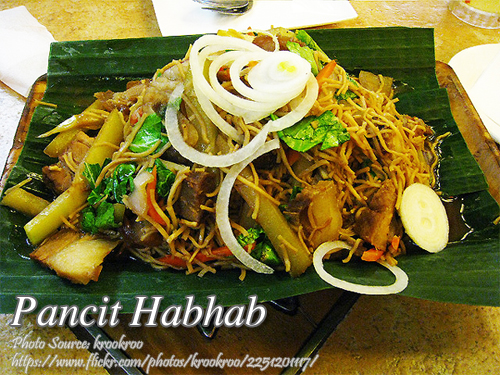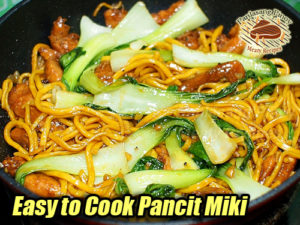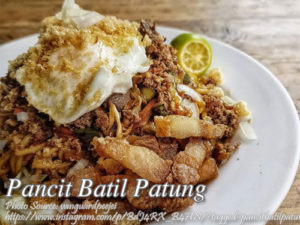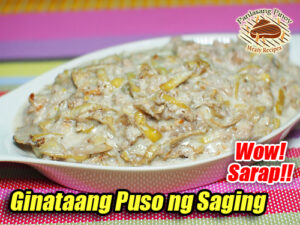Pancit habhab is one of the popular stir fried noodles that originated in Lucban, Quezon province. It is very similar to pancit canton but the only difference is the noodles used which is the Lucban miki. Obviously you can only buy Lucban miki in Quezon province. I think the name of this pancit is not derived from the kind of cooking or the ingredients used but how it is eaten. It is eaten without utensils, just a small piece of banana leaf and eating it by putting it directly in your mouth.
This is the old fashion way of vendors selling this noodles in the past instead of the modern styrofoam or small plastic bags which are bad for the environment. There are varieties of using garnishing on pancit habhab. You can add peeled shrimps, chicharo and cabbage but the recipe here is just using pork belly, pork liver and some veggies which is cheaper specially if you intend to sell it.
Pancit Habhab: A Taste of Lucban Tradition
When I think of pancit, I’m immediately transported back to my childhood. Growing up in a big family, pancit was always at the center of every occasion—from birthdays to fiestas. But nothing comes close to the charm of pancit habhab, a dish that carries not just flavor but a slice of history and culture from Lucban, Quezon.
I first encountered the dish during a family trip to Quezon to visit my Tita Sonia. She had insisted we try the town’s signature dish, and, true enough, I was hooked after the first bite. The unique way it’s served—on a strip of banana leaf, eaten straight from the hand without utensils—adds a rustic, nostalgic vibe. Tita Sonia shared stories of how vendors used to sell this dish on the streets, long before plastic containers took over. Eating it felt like stepping into the past, savoring a dish the way locals have for generations.
What Makes Pancit Habhab Special?
At first glance, you might mistake pancit habhab for other Filipino noodle dishes like pancit canton, but the secret lies in the noodles. Instead of the usual egg noodles, Lucban miki is used—a fresh, slightly chewy noodle that absorbs flavors beautifully. It’s a little tricky to find Lucban miki outside Quezon, but if you can get your hands on it, the effort is well worth it.
The name habhab itself is tied to the unique way it’s eaten. “Habhab” refers to the act of eating something straight into your mouth—no forks, spoons, or chopsticks. Just you, the noodles, and the banana leaf. This method might seem simple, but it’s actually what elevates the experience, making it fun and interactive, especially for first-timers.
Cooking Pancit Habhab the Traditional Way
When I asked my uncle Jaime, a retired cook who once worked in a panciteria, about the secrets to pancit habhab, he told me it’s all about layering flavors. The process starts with boiling pork belly, which not only tenderizes the meat but also produces a rich broth that will later infuse the noodles. The broth is the backbone of the dish, tying together the savory, smoky, and umami flavors.
The addition of pork liver may not be for everyone, but it gives the dish a distinct richness. I remember my cousin Lito wrinkling his nose when he saw me sautéing the liver, but after tasting it, even he couldn’t deny how much it added to the depth of flavor.
The key to achieving perfectly cooked vegetables is timing. Sautéing chayote, carrots, and pechay separately ensures they retain their vibrant color and crisp texture. These veggies not only make the dish visually appealing but also provide a refreshing contrast to the savory noodles.
Why Simmering Works Wonders
One thing I’ve learned from watching my mom cook pancit is the importance of simmering. After adding the Lucban miki noodles to the broth, let them simmer gently. This allows the noodles to absorb all the flavors while softening to just the right texture. Don’t rush this step! Stirring occasionally helps distribute the broth evenly, ensuring every strand of noodle is packed with flavor.
Once the broth has mostly been absorbed, the dish comes together beautifully. At this point, I like to mix in half of the cooked vegetables for a balanced bite in every forkful. The other half, I reserve as a garnish for a stunning final presentation.
A Dish Steeped in Culture
Pancit habhab isn’t just about satisfying hunger—it’s about experiencing the culture of Lucban. This dish has roots in the farming community, where locals needed something hearty and easy to eat in the fields. Over time, it became a staple in fiestas and gatherings, showcasing not just the flavors of the region but also the resourcefulness of its people.
The use of banana leaves instead of plates is another nod to the dish’s humble beginnings. Aside from being eco-friendly, the banana leaf imparts a subtle aroma to the noodles, enhancing the overall eating experience. It’s these little touches that make it so special, a reminder that food is not just about ingredients but also the stories behind them.
Making Pancit Habhab at Home
Cooking pancit habhab might sound daunting at first, but it’s actually quite beginner-friendly. The key is to prepare all the ingredients beforehand—your tender pork belly, fresh Lucban miki, and vibrant vegetables. Having everything ready to go ensures a smooth cooking process and prevents the noodles from overcooking.
If Lucban miki isn’t available in your area, you can substitute it with fresh egg noodles or even pancit canton. While it won’t be exactly the same, it will still be delicious. Just be sure to adjust the simmering time to match the type of noodles you’re using.
Food for Thought
Did you know that noodles, like pancit, symbolize long life and prosperity in Filipino culture? It’s no wonder pancit habhab is a popular dish for birthdays and other celebrations. Every time I cook this dish, I’m reminded of my family’s stories, the laughter we shared over banana leaves, and the simple joys of eating together.
Whether you’re from Lucban or halfway around the world, it is more than just a meal—it’s a slice of heritage you can savor with every bite. So the next time you’re in the mood for something hearty, why not give this noodle dish a try? Serve it on banana leaves, gather your loved ones, and enjoy the tradition.
How to Cook Pancit Habhab
Ingredients
- 500 grams Lucban miki noodles
- 1/4 kilo pork belly
- 200 grams pork liver optional
- 1 pc carrot julienned
- 1 pc chayote sliced into large strips
- 2 bunches pechay chopped
- 1 pc onion chopped
- 3 cloves garlic minced
- salt and pepper to taste
- 4 cups pork broth
- 3 Tbsp. soy sauce
- 1 Tbsp. cooking oil
- 2 pcs onion sliced into rings (for garnishing)
Instructions
How to cook Pancit Habhab:
- Season with salt and pepper and boil the pork belly in 6 to 7 cups water until the pork is tender. Drain the pork and slice thinly then set aside. Reserve the pork broth or later use.
- In a medium size wok, heat some oil and saute the chayote for half a minute. Then add the carrots and pechay. Saute until the vegetables are half cooked. Remove from the wok and set aside.
- In the same wok, heat some oil and saute garlic and onion until onions are soft. Add the pork and saute until slightly brown and some of the fat have rendered. Season with salt and pepper.
- Add the pork liver and saute for a few minutes until the liver is slightly brown. Pour the pork broth, soy sauce and bring to a boil.
- Simmer until the pork is tender. Then add the miki noodles and simmer. Stir the noodles until it absorbed most of the broth and the noodles are cooked.
- Turn off heat and mix the vegetables on the noodles. Stir until the veggies are evenly distributed. You can also divide the veggies and mix only half on the noodles and the remaining is garnish it on individual servings. Serve it using banana leaves instead of plates and garnish with sliced onion rings on individual servings.
Notes
Cooking Tips:
Use Fresh Lucban Miki for Authentic Flavor
The unique taste and texture come from Lucban miki, fresh noodles made locally in Quezon. If you’re lucky enough to find these noodles, make sure they are freshly made to retain their chewy and slightly springy texture. If you can’t find Lucban miki, use fresh egg noodles as a substitute, but keep in mind that the flavor won’t be exactly the same.Don’t Overcook the Vegetables
The vibrant vegetables such as chayote, carrots, and pechay, add both flavor and crunch. Sauté them just until they are half-cooked to preserve their natural sweetness and crisp texture. Overcooked vegetables can become mushy and lose their color, so remove them from the wok early and add them back at the end for a perfect balance.Simmer the Noodles for Full Flavor Absorption
Letting the noodles simmer in the pork broth ensures they soak up all the rich, savory flavors. Stir gently but frequently to prevent the noodles from sticking together and to distribute the broth evenly. This step is crucial for achieving that signature taste and aroma that makes it a standout dish.





